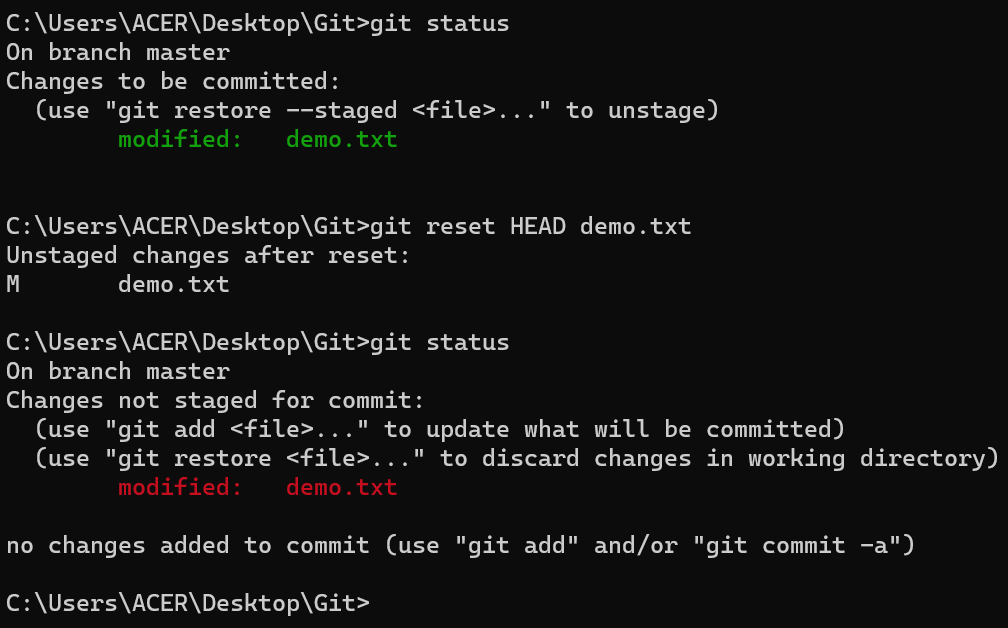Git Reset All Unstaged Changes
Staging Changes in Git:
Git, a popular version control system, provides a convenient way to manage and track changes in your codebase. One of the essential concepts in Git is staging changes. Staging allows you to selectively prepare and group changes before committing them to the repository. This helps in keeping your commits organized and offers a level of control over what changes are included in each commit.
To stage changes, you need to use the “git add” command. This command takes one or more file names as arguments and adds them to the staging area. Once a file is staged, it is ready to be committed.
Understanding Staged and Unstaged Changes:
Before we delve into resetting unstaged changes, it’s crucial to differentiate between staged and unstaged changes. Staged changes are the ones that have been added to the staging area using the “git add” command. Unstaged changes, on the other hand, refer to modifications in your working directory that have not been staged yet.
Identifying Unstaged Changes:
To identify unstaged changes in your repository, you can use the “git status” command. When executed, this command displays the current status of your working directory, including any modified files that haven’t been staged yet.
The output of “git status” shows the files with modifications. These files are listed under the “Changes not staged for commit” section. It is important to review this output to understand the changes that are at risk of being lost if not staged or committed.
Resetting All Unstaged Changes:
When you want to undo all the unstaged changes and revert your working directory to the last committed state, the “git reset” command comes into play. By using the –hard flag with the “git reset” command, you can reset all modifications, effectively discarding the unstaged changes.
Caution should be exercised while using the –hard flag with “git reset” as it will reset all changes, including both unstaged and staged changes, to match the last commit. This action cannot be undone easily, which is why it is recommended to backup your changes or create a commit before executing the “git reset –hard” command.
Recovering from Accidental Resets:
In case you accidentally perform a reset and lose important changes, Git provides a way to recover them through its reflog feature. The reflog retains a record of all the actions performed on your branches, allowing you to revert to a previous state, even after using “git reset –hard”.
By executing the “git reflog” command, you can see a chronological list of all the branch operations that have taken place. Each entry in the reflog has a corresponding commit hash, allowing you to reset your branch back to a desired state before the accidental reset.
Resetting Specific Unstaged Changes:
While resetting all unstaged changes may sometimes be necessary, there are situations where you may only want to undo specific modifications in certain files. In such cases, the “git checkout” command comes to the rescue.
By running “git checkout
If you have multiple files with unstaged changes that you want to undo, you can use wildcards with the “git checkout” command. For example, using “git checkout *.txt” will revert unstaged changes made to all files with the .txt extension.
Recovering Deleted Files or Changes:
In some instances, you may have accidentally deleted a file or deleted specific changes made to a file that was originally staged. In such cases, Git’s “git reset” command can help you recover.
By using the “git reset” command, accompanied by the commit hash or branch name, you can revert your repository back to a state before the deletion or changes took place. This will effectively restore the deleted files or undo the unwanted changes, allowing you to recover your work.
Best Practices and Precautions:
When it comes to resetting unstaged changes, certain best practices and precautions should be followed to ensure the safety of your codebase:
1. Understand the consequences: Before executing any reset command, make sure you fully understand the changes that will be lost. Review the output of the “git status” command and ensure that you are discarding the intended modifications.
2. Backup your changes: Creating a commit or backing up your changes using Git’s stash feature can provide an extra layer of protection. This allows you to revert back to the backup if needed.
3. Collaborative practices: If you are working in a team, communicate with your teammates about your intent to reset unstaged changes. Ensure that everyone is aware and any necessary precautions are taken to avoid data loss.
Common Scenarios and Solutions
1. Handling conflicting changes: In cases where there are conflicting changes in your working directory, Git may prevent you from performing a reset. You will need to resolve the conflicts by using tools like “git mergetool” or manually editing the files.
2. Restoring specific parts of unstaged changes: If you want to restore only specific parts of unstaged changes, you can create and apply Git patches. Git patches allow you to select the specific lines or chunks of code you want to restore, providing granular control over the changes.
3. Troubleshooting common issues: If you encounter issues like “Git discard changes,” “Git reset staged changes,” “Git discard all local changes,” “Git reset all file changes,” “Git discard change file,” “Git discard file,” “Unstaged changes after reset,” or “Discard changes là gìgit reset all unstaged changes”, refer to Git’s official documentation or seek help from the Git community.
In conclusion, Git provides powerful features to manage and undo changes in your codebase. By understanding and using commands like “git reset” and “git checkout,” you can effectively revert and discard unstaged changes, ensuring a clean and organized development workflow. However, caution must be exercised to avoid unintended loss of important modifications.
How To Discard Unstaged Changes In Git
Keywords searched by users: git reset all unstaged changes Git discard changes, Git reset staged changes, Git discard all local changes, Git reset all file changes, Git discard change file, Git discard file, Unstaged changes after reset, Discard changes là gì
Categories: Top 28 Git Reset All Unstaged Changes
See more here: nhanvietluanvan.com
Git Discard Changes
Introduction:
Git is a popular version control system that allows programmers to track changes in their codebase over time. It offers a range of powerful features, including the ability to undo mistakes and discard changes that you no longer need. In this article, we will explore how to discard changes in Git, from simple file-level modifications to more advanced branch and commit manipulations. Read on to discover how to reset your repository and regain control over your code.
Discarding Changes at the File Level:
Sometimes, you may find yourself making changes to a file only to realize that you want to revert back to the original version without preserving the modifications. Git provides a straightforward command called “git checkout” that enables you to accomplish this. By running the command `git checkout
It’s important to note that this command cannot be undone, meaning that any unsaved changes will be permanently lost. Therefore, exercise caution and ensure your modifications are backed up or committed before running “git checkout”.
Discarding Changes at the Branch Level:
In Git, branches allow you to isolate different lines of development, making it easy to work on new features or bug fixes without interfering with the main codebase. However, there may be instances where you decide the changes you made in a branch are no longer needed, and you want to discard them entirely.
To discard changes at the branch level, you have a few options, depending on your needs. If you want to delete the branch and all the changes it contains, you can use the command `git branch -D
Alternatively, if you want to keep the branch but discard all the changes within it, you can use the `git reset` command with the `–hard` flag. For instance, `git reset –hard master` will reset the branch to match the “master” branch and eliminate all commits and changes that deviate from it.
Discarding Changes at the Commit Level:
At times, you may want to discard a specific commit along with its changes. Git provides different methods to achieve this, depending on the commit’s age and the level of changes you want to undo.
If the commit you want to discard is the most recent one, you can use the command `git reset –hard HEAD~1`. This command resets the repository to the state before the last commit and removes the last commit along with all its changes.
However, if you want to discard a commit that is older or not the most recent, you need to use the `git rebase` command. The `git rebase` command allows you to modify the commit history and can be used to delete, edit, or reorder commits. Discarding a specific commit can be accomplished by running `git rebase -i
FAQs about Discarding Changes in Git:
Q: Can I undo a Git command that discards changes?
A: Unfortunately, Git commands that discard changes, such as `git checkout` and `git reset –hard`, cannot be undone. It is crucial to make sure you have saved or committed any necessary changes before executing these commands.
Q: Can I selectively discard changes within a file?
A: No, Git only provides options to discard all local changes to a file or restore it to the previous committed version. If you want to preserve some modifications while discarding others, you can manually copy the desired changes to a backup file before running the discard command.
Q: Can I retrieve the discarded changes at a later time?
A: If the changes were committed or can be found in a previous commit, you can retrieve them by checking out the relevant commit or creating a new branch from a previous commit.
Q: How can I discard untracked files in Git?
A: To discard untracked files, you can use the command `git clean -df`. This will delete all untracked files and directories within your repository, so be cautious when running this command.
Q: Are there any precautions I should take before discarding changes in Git?
A: Yes, it is always recommended to save or commit your changes before discarding them. Additionally, ensure that you have a backup or a copy of any critical modifications, as Git’s discarding commands are irreversible.
Conclusion:
Discarding changes in Git allows you to undo mistakes, reset files, branches, or commits, and regain control over your code repository. By understanding the various discard commands available, you can confidently revert changes at different levels within your projects. Remember to exercise caution and make backups before discarding changes, as these actions cannot be undone. Git’s versatility and powerful features make it an invaluable tool for managing and controlling your codebase.
Git Reset Staged Changes
Introduction:
Git, the widely popular version control system, provides developers with a wide array of powerful tools and features to manage their codebase efficiently. One such tool is the “git reset” command, which allows users to undo their staged changes. This article aims to explore the Git reset staged changes command in-depth, discussing its functionality, use cases, and potential pitfalls.
Understanding the Staging Area:
Before delving into git reset, it is crucial to understand the concept of the staging area. When working with Git, changes made to files in your local repository require explicit staging before they can be committed and pushed to the remote repository. The staging area acts as a middle ground between the working directory, where you make changes, and the repository itself.
What is Git Reset?
Git reset is a command in Git that allows you to reset the state of your repository or undo specific changes. When used with the “—-soft” argument, it modifies the commit history, and with the “—-mixed” argument, it modifies the commit history and the staging area. Lastly, using the “—-hard” argument will modify the commit history, staging area, and working directory.
Resetting Staged Changes:
To undo changes in your staging area, you can use the git reset command with the “—-mixed” or “—-hard” argument. For example, to unstage all the changes in the staging area and retain the modifications in your working directory, the following command can be used:
“`
git reset –mixed
“`
After executing this command, all changes that were staged for the next commit are moved back to the working directory. This can be helpful if you realize you have included unintended changes or want to review modifications before committing.
In cases where you want to discard the changes in both the staging area and the working directory, the following command with the “—-hard” argument can be used:
“`
git reset –hard
“`
This command will completely discard the staged changes and revert your working directory to the state of the previous commit. It is important to note that any modifications made to tracked files in your working directory will be permanently lost.
Common Use Cases:
1. Unstage specific files or directories:
If you only wish to unstage specific files or directories, you can simply specify them after the git reset command. For example:
“`
git reset –mixed path/to/file.txt
“`
This command will unstage the specific file without affecting other staged changes.
2. Fixing a mistakenly staged change:
Sometimes, during the staging process, you may inadvertently include changes or files that were not intended for the commit. In such cases, using git reset –mixed can help you rectify the mistake.
FAQs:
Q1. Will git reset affect remote repository history?
A1. Git reset only modifies the local repository history. To update the remote repository, one needs to push the changes explicitly after a reset.
Q2. Can I retrieve changes discarded by git reset –hard?
A2. No, git reset –hard irreversibly discards changes in both the staging area and working directory. Ensure you have a backup or can recover the changes from another source.
Q3. Is git reset safe to use?
A3. Git reset is a powerful command, but it should be used with caution. Always ensure you have a backup or are working with committed changes before performing a reset.
Q4. How can I check the changes in my staging area?
A4. You can use the git status command to see the changes in your staging area, working directory, and untracked files.
Q5. Can git reset affect other branches?
A5. By default, git reset operates on the current branch. However, you can specify a different branch or commit to modify the history of that branch instead.
Conclusion:
The git reset command is a versatile tool in Git that allows developers to undo staged changes effectively. Understanding its different arguments and use cases ensures that changes can be managed efficiently, avoiding unintended modifications and reducing the potential for code errors. Remember to exercise caution while using git reset, especially when opting for the “—-hard” argument, as it can lead to permanent loss of changes. Regularly backing up your work is always a good practice to maintain.
Images related to the topic git reset all unstaged changes

Found 27 images related to git reset all unstaged changes theme















































Article link: git reset all unstaged changes.
Learn more about the topic git reset all unstaged changes.
- How do I discard unstaged changes in Git? – Stack Overflow
- How to Discard Unstaged Changes in Git | Baeldung
- How to Discard Unstaged Changes in Git – W3docs
- Git Restore All Unstaged and Untracked Files … – Nick Janetakis
- How to Discard Unstaged Changes in Git – Stack Diary
- Undo options in Git – GitLab Documentation
- Discard Unstaged Changes In Git | Git Clean -df | Git Restore
- git Cheat Sheet – LiTHe kod
- How to Quickly Undo Staged and Unstaged Changes in Git?
See more: nhanvietluanvan.com/luat-hoc